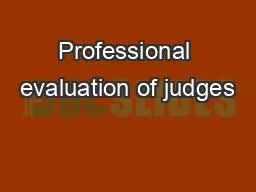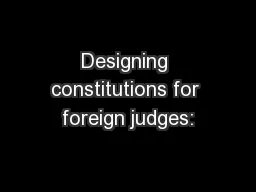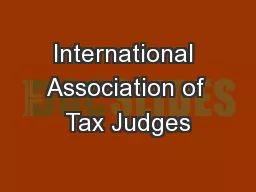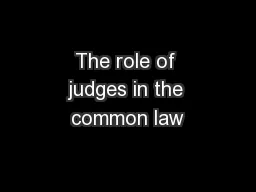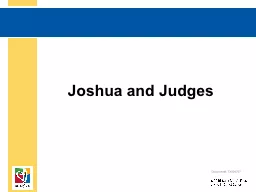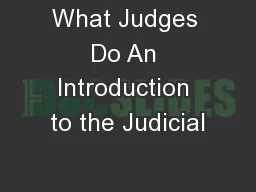PPT-Professional evaluation of judges
Author : bikersnomercy | Published Date : 2020-07-02
Montenegro Experience of Evaluation Panel The reasons for establishment of the system for evaluation of judges In the practice of Montenegro so far there
Presentation Embed Code
Download Presentation
Download Presentation The PPT/PDF document "Professional evaluation of judges" is the property of its rightful owner. Permission is granted to download and print the materials on this website for personal, non-commercial use only, and to display it on your personal computer provided you do not modify the materials and that you retain all copyright notices contained in the materials. By downloading content from our website, you accept the terms of this agreement.
Professional evaluation of judges: Transcript
Montenegro Experience of Evaluation Panel The reasons for establishment of the system for evaluation of judges In the practice of Montenegro so far there has been no system for . 03. -. 04. A CD of this message will be available (free of charge) immediately following the service.. It will also be available for podcast later this week at calvaryokc.com. Warren Wiersbe ~ . "When God goes to war, He usually chooses the most unlikely soldiers, hands them the most unusual weapons, and accomplishes through them the most unpredictable results.". 17. -. 18. A CD of this message will be available (free of charge) immediately following the service.. It will also be available for podcast later this week at calvaryokc.com. Micah. ~ . who is like Jehovah?. “Into the Land”. Joshua—Outline. Crossing the Jordan (1-5). Jericho, Bethel/Ai (6:1-8:29). Covenant Ceremony (8:30-35). “Southern Campaign” (9-10). “Northern Campaign” (11). Defeated Kings & Unconquered lands (12-13). Israel’s downward spiral. INTRODUCTION. The Historical Setting. The historical scope of this period: . . from . . the death of Joshua (1390 BC) . . . to . . the days of Samuel . The Pacific experience. Anna Dziedzic. PhD Candidate, Melbourne Law School. Constitution Transformation Network . Overview of research. Why are foreign . judges?. How . are they recruited and appointed, and . Tech Mahindra Limited v Commissioner of Taxation. Justice Jennifer Davies. IATJ . 7. th. Assembly. September 30. th. October 1. st. , 2016. Madrid, Spain. . International Association of Tax Judges. The . operation of the common law depends heavily on the expertise of the judge. .. He . or she must be able to identify and apply appropriate precedents to match the facts of the case being heard, and also to . One . day Samson went to Gaza, where he saw a prostitute. He went in to spend the night with her. . The . people of Gaza were told, “Samson is here!” So they surrounded the place and lay in wait for him all night at the city gate. They made no move during the night, saying, “At dawn we’ll kill him.”. God works . with, in, and . through . people to accomplish . His . purpose & display His . Character. . Judges . 16:15-17. Then she said to him, "How can you say, 'I love you,' when you won't confide in me? This is the third time you have made a fool of me and haven't told me the secret of your great strength." 16 With such nagging she prodded him day after day until he was tired to death. . He . gave them into the hands of the . Midianites. . . Romans 6:16. Don’t you know that when you offer yourselves to someone as obedient slaves, you are slaves of the one you obey—whether you are slaves to sin, which leads to death, or to obedience, which leads to righteousness?. said . to his mother, “The eleven hundred shekels of silver that were taken from you and about which I heard you utter a curse—I have that silver with me; I took it.”. Then his mother said, “The Lord bless you, my son!”. Joshua. Joshua, the successor to Moses. ,. leads the Israelites into Canaan, the Promised Land.. Canaan was promised by God to Abraham.. The Canaanites held polytheistic beliefs and refused to hand over their land to the Israelites.. It will also be available for podcast later this week at calvaryokc.com. Judg. 21:25 ~ . In those days there . was no. king in Israel; everyone did . what was. right in his own eyes.. Judges. 19. -. Branch in North Carolina. Three Branches of Government . Legislative Branch – Makes the law. Executive Branch – Enforces the law. . Judicial Branch – Interprets and applies the law. James Madison.
Download Document
Here is the link to download the presentation.
"Professional evaluation of judges"The content belongs to its owner. You may download and print it for personal use, without modification, and keep all copyright notices. By downloading, you agree to these terms.
Related Documents

